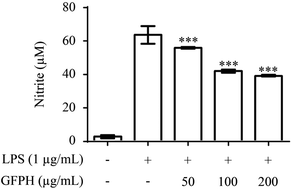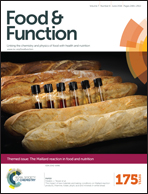The anti-inflammatory effect of a glycosylation product derived from the high hydrostatic pressure enzymatic hydrolysate of a flatfish byproduct
Abstract
In this study, flatfish byproducts were hydrolyzed by Protamex at high hydrostatic pressure and glycosylated with ribose to utilize the protein of flatfish byproducts as a nutraceutical. We investigated the anti-inflammatory effects of glycosylated fish byproduct protein hydrolysate (GFPH) and its anti-inflammatory mechanisms were elucidated in lipopolysaccharide (LPS)-stimulated RAW 264.7 mouse macrophage. The results showed that GFPH suppresses LPS-induced production of nitric oxide (NO) and prostaglandin E2 (PGE2) and expression of inducible nitric oxide synthase (iNOS) and cyclooxygenase-2 (COX-2) dose-dependently. The enzyme-linked immunosorbent assay (ELISA) kit clearly demonstrated that GFPH significantly reduced the production of pro-inflammatory cytokines such as, interleukin (IL)-6, interleukin (IL)-1β and tumor necrosis factor (TNF)-α, and monocyte chemoattractant protein (MCP)-1. Moreover, GFPH reduced nuclear factor κB (NF-κB) and mitogen-activated protein kinase (MAPK) activation. These results indicate that the inhibitory effects of GFPH on LPS-induced NO and PGE2 production might be due to the suppression of the NF-κB and MAPKs signaling pathways. Therefore, these results suggest that flatfish byproducts are latent bioactive resources and GFPH may have potential as a therapeutic agent in the treatment of various inflammatory diseases.

- This article is part of the themed collection: The Maillard reaction in food and nutrition

 Please wait while we load your content...
Please wait while we load your content...